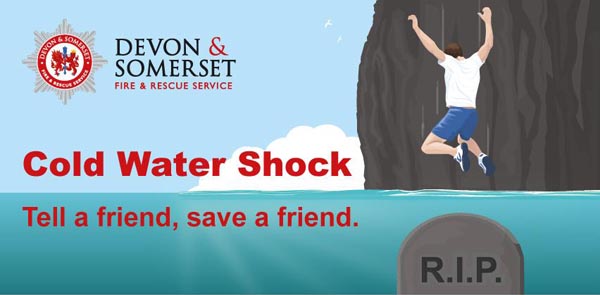Fire and rescue services across the UK are supporting the Chief Fire Officers Association’s (CFOA’s) first Drowning Prevention and Water Safety Week which is taking place till April 19.
THE campaign highlights the danger of Cold Water Shock, which causes a number of fatalities every year because young people – even those who are strong swimmers – are often unaware of the effect that swimming in open water can have on their bodies and on their ability to swim.
Fire and Rescue Services will be encouraging young people aged 16-30 to ‘Tell a Friend. Save a Friend.’ as even on a warm day, the temperature of the water in a reservoir, quarry or lake can remain very cold. The shock of cold water can then create a physical response that can make it more difficult to swim, and may cause death.
As part of the week, CFOA and fire and rescue services are showing competition winning, hard-hitting images created by students on the Advertising and Branding Design course at University of Wales Trinity Saint David. The drowning prevention posters were chosen by CFOA’s Water Safety Lead, Dawn Whittaker, in conjunction with water safety campaigner Beckie Ramsay, whose Doing it for Dylan water safety campaign was created following the tragic drowning of her 13-year-old son in 2011.
The overall winning poster was designed by student Tilly Baker, who compared the effects of cold water shock to being wrapped in clingfilm.
Six other posters were also chosen to promote the week, with student Suzi Niculescu devising the Tell a Friend. Save a Friend. message.
CFOA’s Water Safety Lead, Dawn Whittaker, warned: “While reservoirs, lakes, rivers and other inland water may look safe and inviting, particularly on a warm day, there are hidden dangers below the surface that could make you ill, hurt you, and – at worst – could kill you. Cold Water Shock is a physical response that can not only affect your breathing, but will reduce your muscle ability and can even lead to a heart attack.”
Speaking of further dangers, Dawn added: “Moving water, such as rivers, may look calm but may have strong currents below the surface which can carry even strong swimmers into danger. And, of course, from out of the water, or above, you may not be able to see dangerous obstructions such as large rocks or dead branches that can cause you injury. You may also want to consider the fact that open water is untreated, and may be polluted with bacteria and algae that can give you stomach upsets, or even with organisms that can cause a number of nasty illnesses including Weil’s Disease, Trachoma and Whipworm.”
The CFOA hopes its new Water Safety Week will reinforce the important work being done by the Royal Life Saving Society’s Drowning Prevention Week (20-28 June), the Royal National Lifeboat Institute’s Respect the Water campaign (July), and the joint RNLI/ASA’s Swim Safe swimming and beach safety ‘roadshow’ in July and August.


















You must be logged in to post a comment.